One definition of play is “to occupy oneself in an activity for amusement or recreation”. Many bird species are known to play and I photographed a juvenile Western Grebe doing just that three days ago at Farmington Bay WMA.
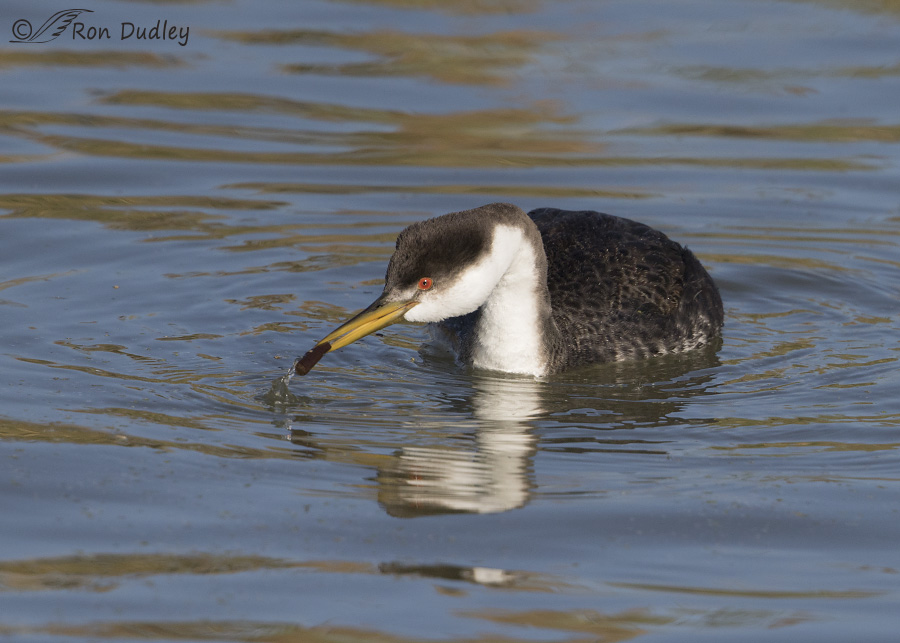
1/4000, f/6.3, ISO 500, Canon 7D Mark II, Canon EF 500mm f/4L IS II USM + 1.4 tc, not baited, set up or called in
The grebe spotted a waterlogged stick or piece of vegetation just below the surface of the water, reached down to grab it and after manipulating it in its beak for a moment it…
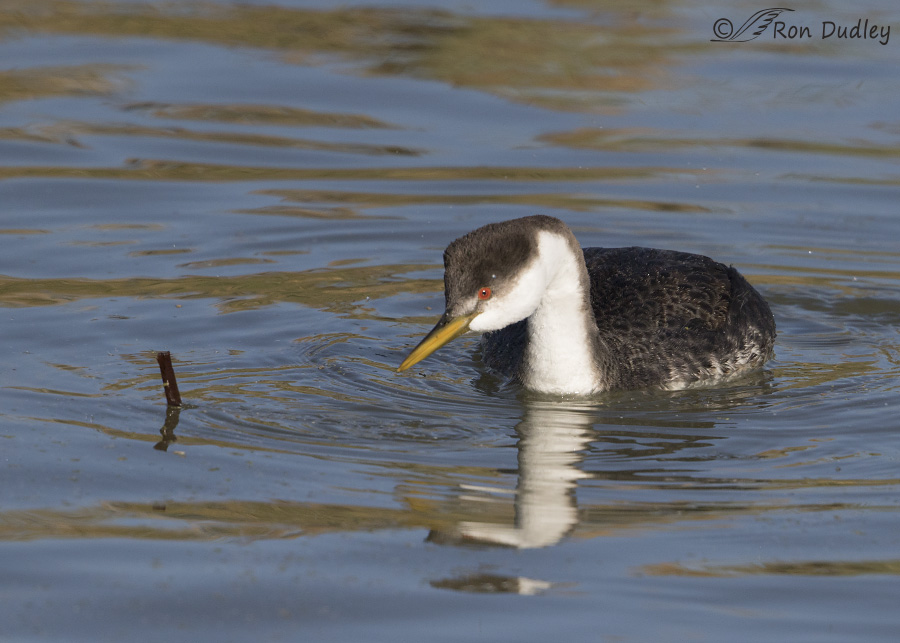
1/5000, f/6.3, ISO 500, Canon 7D Mark II, Canon EF 500mm f/4L IS II USM + 1.4 tc, not baited, set up or called in
gave the stick a fling so that it landed a few inches in front of the bird.
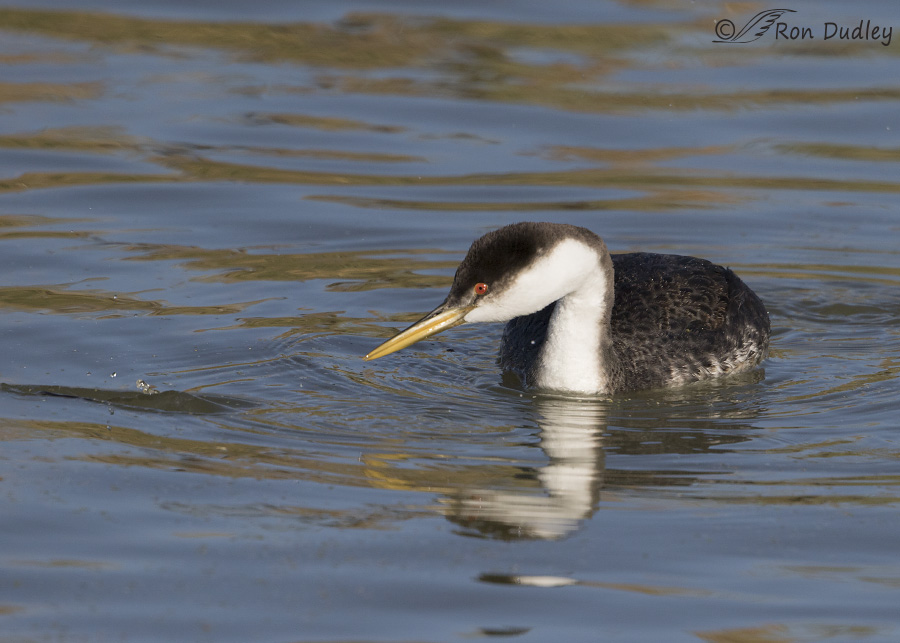
1/5000, f/6.3, ISO 500, Canon 7D Mark II, Canon EF 500mm f/4L IS II USM + 1.4 tc, not baited, set up or called in
The grebe obviously watched where it landed…
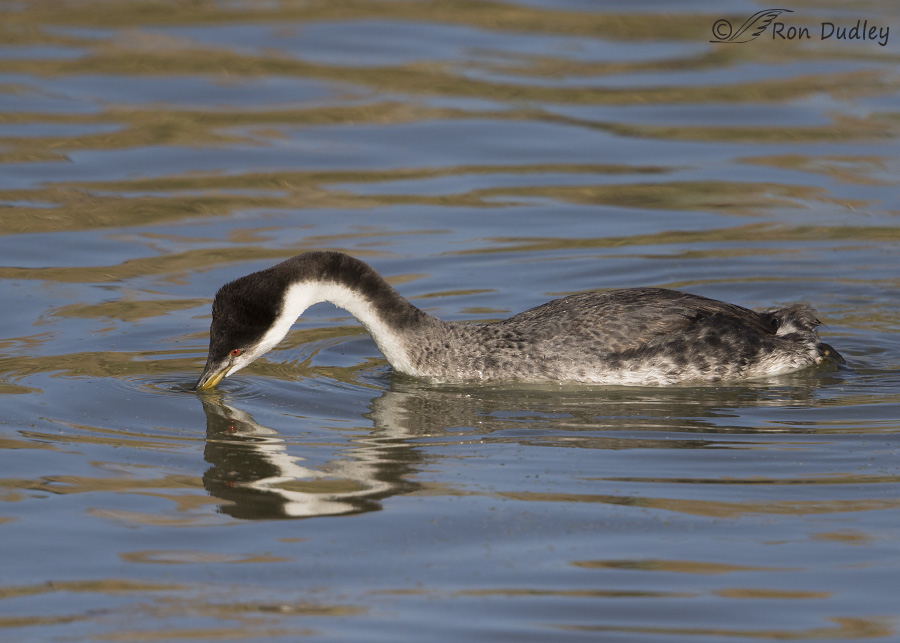
1/4000, f/6.3, ISO 500, Canon 7D Mark II, Canon EF 500mm f/4L IS II USM + 1.4 tc, not baited, set up or called in
retrieved it a second time…
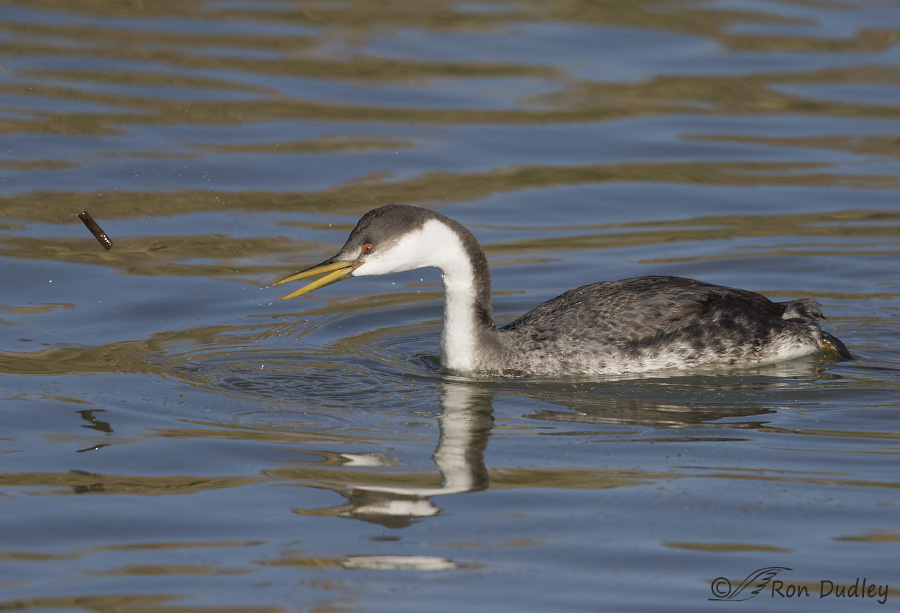
1/4000, f/6.3, ISO 500, Canon 7D Mark II, Canon EF 500mm f/4L IS II USM + 1.4 tc, not baited, set up or called in
and then gave it another fling.
Some might say that claiming that birds play is being anthropomorphic but I disagree. In fact, I’m beginning to believe that the use of the term anthropomorphism is becoming somewhat anachronistic as it is often applied to the behaviors of higher vertebrates. The term has its place but I’m of the opinion that humans and many animals share more behaviors and even emotions than we have long thought they did.
Cornell’s Birds of North America Online (BNA) includes a “play” category in their descriptions of the behavior of many bird species. For Western Grebes they list play as simply “not reported”. Well, I’d report this example to them if I thought it would do any good but in the past when I’ve reported “unknown” bird behaviors to BNA (documented by photographs) it has been ignored. Perhaps they only accept behavioral examples as verified when they come from bona fide scientific researchers but I really don’t know.
Ron


I like your style Patty. Roar!!
Years ago, before I married my Hubby, he had a Tortoise. One day my Hubby kept hearing “thud thud thud” After the 3rd time of hearing the sound, he looked out the back window. There was the Tortoise sliding down the steps. All 3 of them. Cement steps at that. The Tortoise would walk around, go up the ramp, then slide down the steps again. I’m with ya’ll. Animals, birds alike, have personalities. Those that refuse to believe, are too stuffy for me.
I liked your story, Jean. A lot. Well observed and well said.
You are definitely singing my song. Animals and birds DO play. And feel rather a lot of other emotions too.
I suspect the people who dismiss it as coincidence/anthromophising/ and the like are just not prepared to admit how similar we are. Because that might mean that they have to climb down from the superiority pedestal they built for themselves…
An interesting theory, EC, and one I wouldn’t disagree with in many cases.
I am so happy to read your comments today. I have always thought it sad that the emotions and fun we seem to see in animals had always be chalked up to anthropomorphism by science. It’s great to have more confirmation that my instincts could be right- our furry and feathered friends really do have feelings.
I’m sure there’s many industries that are not interested in having this idea acknowledged scientifically. I really do find it harder and harder to eat meat these days.
“I’m sure there’s many industries that are not interested in having this idea acknowledged scientifically”
I suspect you’re right about that, Suze.
I’m sooooo sick of “clinical” ” observations being accepted as defining behavior that a I could just spit! Especially when they use terms like, “always” and “never” to describe behaviours experienced in a contrived, atypical, sterile , un-stimulating environment! And most especially with animals I’ve raised, experienced and observed in a variety of non-clinical situations. For examples, i’ve watched sparrows “ski” down a small, frozen snowbank and on an icy section of roof…and they kept repeating the action over and over, until they finally tired of it and moved on to eat. As a former badly-addicted-to-the-sport-skier myself, they sure seemed to be having a very good time…that they kept repeating the action for no other apparent reason than just plain fun, certainly made it look like nothing more than just that…play. Are we anthropomorphizing when we assume another human is having fun …or “playing”. How do we REALLY know? What’s the difference? Jeeeeez! In one frame, that bird even appears to be chuckling! Take that, clinicians!!!
Give’m hell, Patty. I love it.
Great shots wonderful behavioral series Ron! I’ve never seen this behavior.
Charlotte
Thank you, Charlotte.
This series clearly shows playing, IMO. A lot of play is actually the development of skills needed for life, so it should not be surprising that any animal that hunts also plays when young. This is a really fun series, and I’m glad you posted it. Even if BNA doesn’t appreciate your reporting of observed behaviors, we do. I think most of your followers appreciate having their experience of birds enlarged. Thinking about birds and playing just reminded me of watching newly fledged Kestrels playing in the wind. It looked like play, and definitely helped their flying skills.
“Even if BNA doesn’t appreciate your reporting of observed behaviors, we do.”
I appreciated that comment, Susan. A lot.
The behavior that I reported to them was more than just “observed”. I photographed it. I can see why they have to be very careful about what evidence they accept but must admit that I was surprised that photographic evidence apparently wasn’t strong enough…
This is lovely. It’s too bad that your past input has been ignored by the folks at Cornell. They often promote projects that call for information from “citizen scientists”…I don’t know why they would ignore reports from such a learned citizen as yourself. Thanks for the fun post.
“Ignore” might have been too strong a word, Sharon. BNA asked to use my images of the behavior (kingbirds casting pellets) and I allowed it but they never used them and never changed their wording that there was “no information” on pellet casting in the species. And that was several years ago.
But I don’t want to give the wrong impression – anyone who follows my blog knows that I’m a huge fan of BNA. I’ve been a subscriber for years…
Sharon, here’s a little more insight into BNA’s apparent standard for accepting info on birds, from a good friend of mine who is extremely bird knowledgeable and whose instincts and judgment I trust implicitly.
“Too bad about the BNA folks. They didn’t care about our scientists’ multitude of observations on Arctic Warblers either. “Get it published first,” the guy said”.
Ron, now that we humans are paying a little more attention to other species and looking outside of “they’re just animals” paradigm, we’re learning all kinds of things that we didn’t used to know. 😉
Yup!
WE are JUST ANIMALS, too, (either that or we’re plants!)…you know, either Flora or Fauna….easy to forget, isn’t it! We’re just blindly, ignorantly FAUNA and, oh! So forgetful!!!
Ron, I’ve always believe we’re far more alike than we are different. Play is certainly a crucial part in young critters learning to be adults, just like with us–at that point, it’s practice. But sometimes, not much else is happening and play happens. Anthropomorphizing is good as long as you leave the anthro part out of the equation, step out of your humanity for a while and look at things through the eyes of the critter! That might be the biggest gift I learned through falconry. As humans, we’re not used to looking through another’s eyes, but it’s well worth the time to learn that skill. Life is all in your point of view/perspective.
“I’ve always believe we’re far more alike than we are different”
I agree, Laura, at least in the case of higher vertebrates like other mammals and birds. As you go down the evolutionary chain a higher percentage of behaviors seems to be instinctive rather than learned.
Great shots Ron.
I agree that the term anthropomorphism is overused.
To think that animals don’t play is silly, of course they play. In my mind higher animals not only play, but “act out” or do mock battles. I would agree that animals that science has studied to be controlled by instinct probably don’t act out. Certainly birds and mammals do in my mind.
Dick, I think that some folks believe that many mammals play but that birds don’t. In my mind there’s no question that at least some of them do. I wonder how far “down” the evolutionary chain play actually goes – for example, are there any documented examples of play in reptiles? I don’t know, just wondering out loud…
I guess none of those clinical types ever had any experience with a parrot or a parakeet,” play” with just about anything…saw a dog or a cat “play” with its sibling or toy…or saw a horse “play” with a big, rubber ball or a plastic jug, or a dog and a cat “play” with each other…or a ………. Come on!!!
In my opinion, it’s “playing” 🙂 Nice sequence and fun to watch.
I’m of the same opinion, Judy. Thanks.